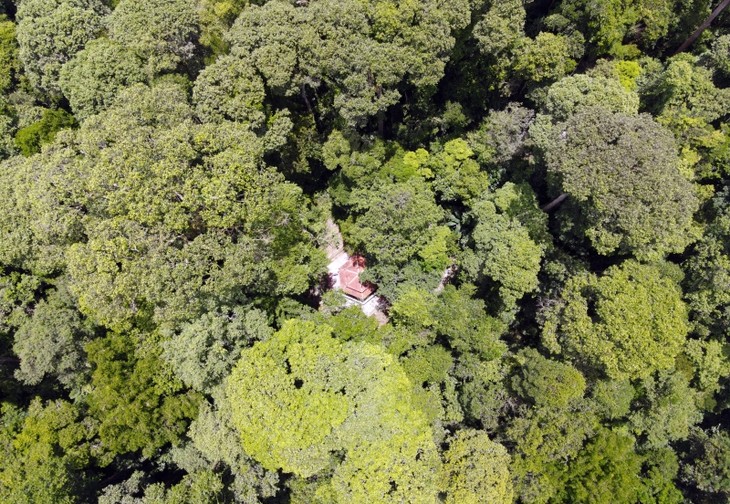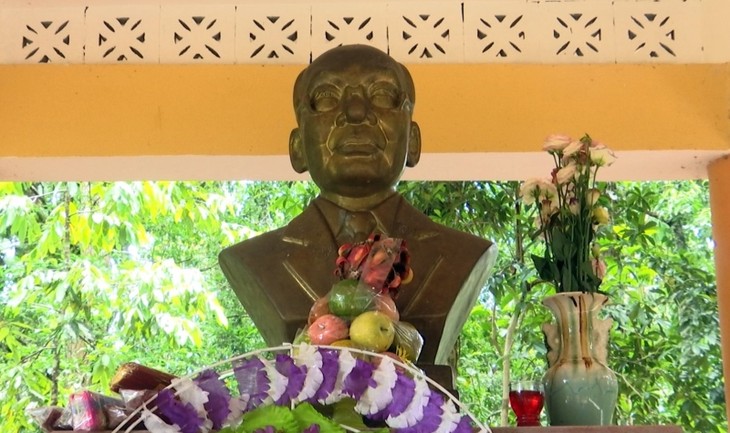There is a forest in Nam Tra My district, Quang Nam province, called the Nam Cong Forest, which was the base of the Inter-region Party Committee V. Under the leadership of Secretary Vo Chi Cong, the Inter-region Party Committee V completed an historic mission during the American war from 1959 to 1964, making the initial success of the strategy of the Southern Revolution in the 1960s. To remember the merits of Mr. Vo Chi Cong, who was then the Chairman of the State Council, ethnic minorities in Nam Tra My district have collaborated to preserve the forest as an historical vestige of the war.

The Nam Cong Forest covers 30 hectares. (Photo: VOV)
The 30-hectare forest at the center of Nam Tra My district is part of the National Historical Site of the Inter-region Party Committee V and its military command. It sheltered the Committee’s officers and soldiers during war.
Ho Thi Ha of Tra Mai commune says that ever since she was small, whenever she went to Nam Cong Forest, she was reminded not to cut down any trees.
For decades, generations of people in Nam Tra My have been passing on the task of protecting the forest, said Ha.
“This forest is Mr. Nam Cong’s. Nobody goes into the forest with a knife. We only pick vegetables. We don’t dare harm the forest or cut down trees,” she noted.
In 1959, Nuoc La Mountain in Tra Mai commune was chosen as the first base of the Inter-region Party Committee V and named the Do Xa Secret Zone, where Secretary Vo Chi Cong lived while leading the revolution.
Under the leadership of Mr. Cong, the military forces and people of the Inter-region Party Committee V contributed significantly to national reunification in 1975.
Ho Van Ni, former Chairman of Nam Tra My district People's Committee, once fought under the leadership of Secretary Vo Chi Cong. He recalled that Mr. Cong was much loved by the local ethnic people .
Ni recounted that the Secretary visited every hamlet to talk to the villagers and personally participated in their work to serve the war effort.
“This is the area where Uncle Nam Cong used to mobilize people to participate in the revolution. Every time we visit the relic, we remember Uncle Nam Cong and the forest. We have asked people not to harm or cut down the trees, but preserve the forest so future generations will remember this period in Vietnam’s history,” Ni told VOV.

The temple worshipping Chairman of the State Council Vo Chi Cong is located at the center of the primeval forest. (Photo: VOV)
After 1964 the liberated area was expanded. The Inter-region Party Committee V was moved to another area, but the Nam Cong Forest was preserved by the local people. In 2003 the Nam Tra My administration proposed that the Ministry of Culture, Sports and Tourism recognize the forest as a national historical relic.
According to Nguyen Van Can, Head of the Communications and Education Section of the Nam Tra My district Party Committee, all the forests in the district total 43,000 hectares.
“Local people understand that keeping the Nam Cong Forest intact means protecting all the forests in the district,” said Can.
Nguyen Thanh Hong, Director of the Quang Nam Department of Culture, Sports and Tourism, says the management and conservation of the Nam Cong Forest serves as a role model for other mountain localities in Quang Nam.
He said all the efforts to preserve the forest demonstrate the gratitude the local ethnic minorities feel toward Uncle Nam Cong.
To protect the forest is to preserve history, but it has the added advantage of preserving an eco-tourism resource that can attract tourists to Nam Tra My.
Long Phi